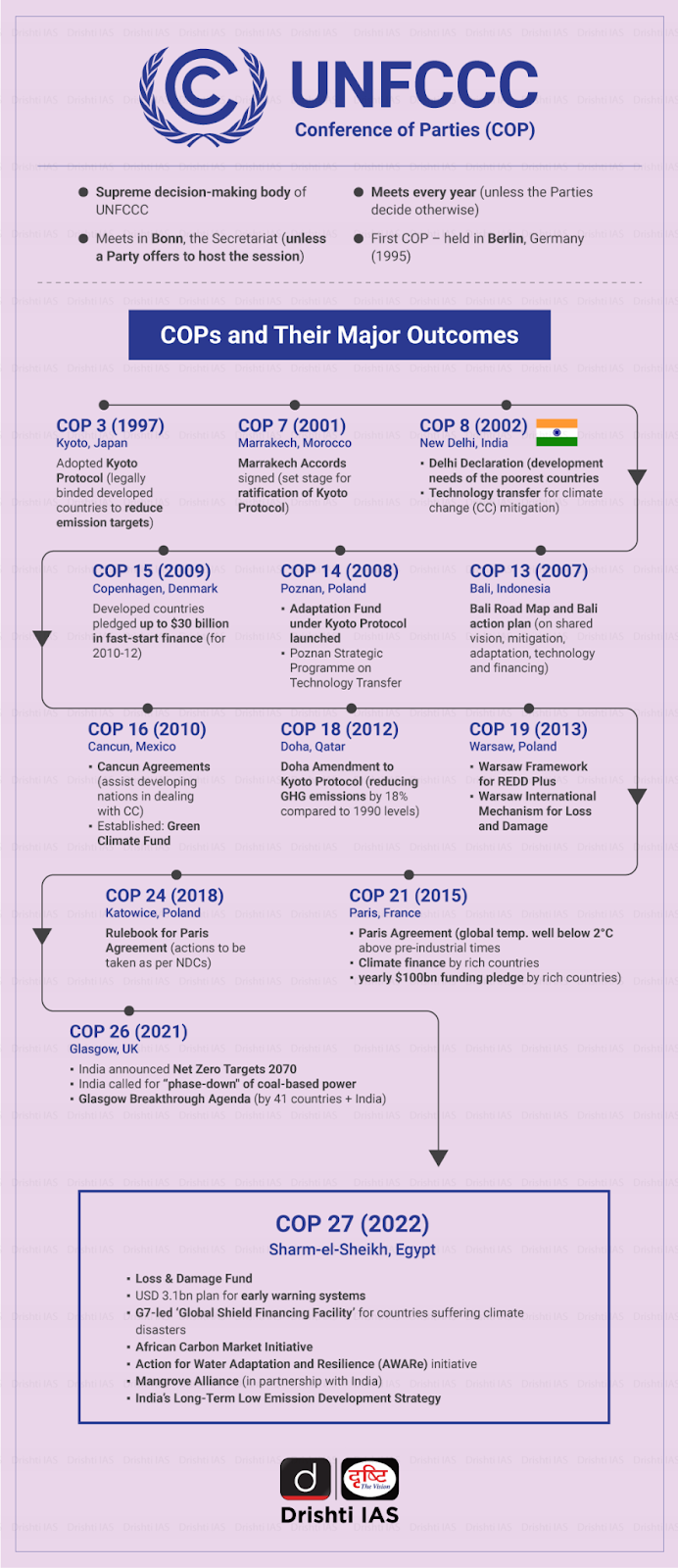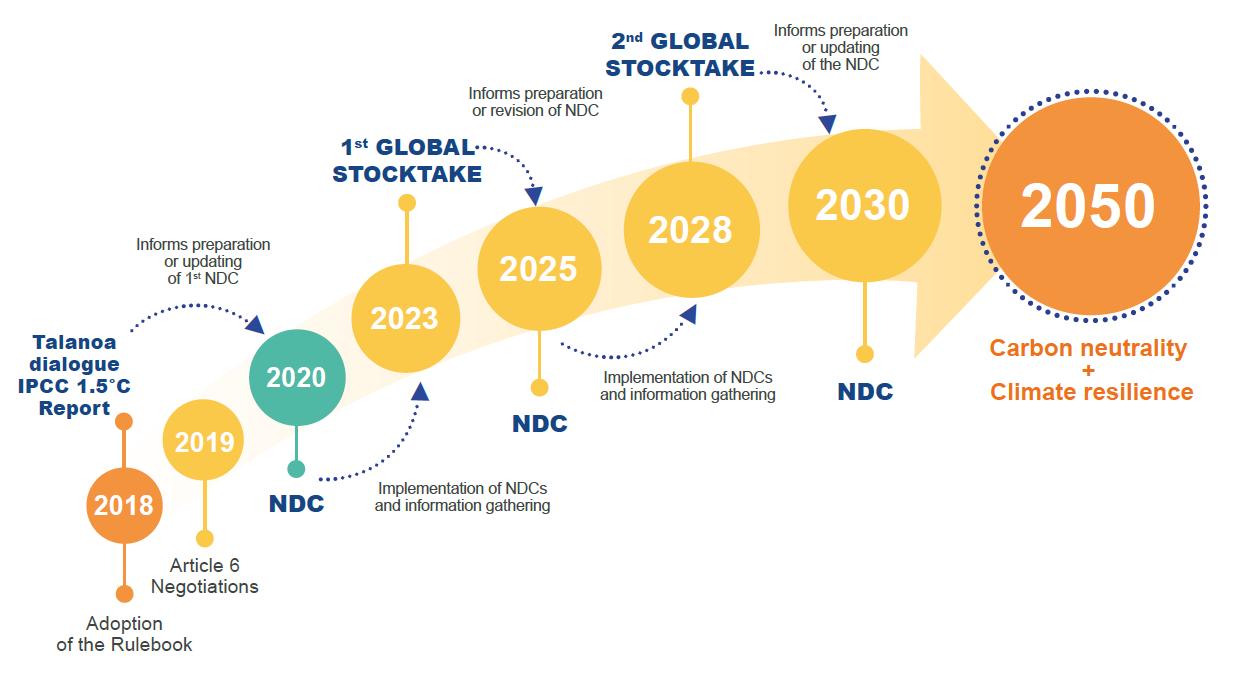Biodiversity & Environment
COP 28: Charting the Roadmap for Climate Action
This editorial is based on “COP28: What were the most important decisions” which was published in The Indian Express on 14/12/2023. It talks about the outcomes and concerns of the 28th Conference of Parties (COP-28) and the urgency of addressing these issues to fulfill commitments and combat climate change effectively.
For Prelims: Conference of Parties (COP-28), United Nations Framework Convention on Climate Change (UNFCCC), Paris Agreement, Global Stocktake, Global Goal on Adaptation, Climate Finance, United Nations Conference on Trade and Development (UNCTAD), Renewable Energy
For Mains: About COPs, Key Outcomes of COP 28, Key Concerns and Way Forward
Recently, the 28th Conference of Parties (COP-28) took place in Dubai, UAE, with representatives from 197 countries presenting their initiatives to curb global warming and engaging in discussions on future climate actions.
The conference yielded a mix of positive outcomes and disappointments, marking a substantial step forward since the Paris Agreement. While some hail it as the conclusion of the fossil fuel era, there are apprehensions about deficiencies in adaptation efforts and troubling gaps in mitigation strategies.
What are COPs?
- COPs are gatherings held within the framework of the United Nations Framework Convention on Climate Change (UNFCCC), a multinational treaty established in 1992.
- These meetings, denoted by the acronym COP, serve as the official sessions of the Conference of the Parties.
- During these sessions, participating countries (Parties) evaluate global endeavors aligned with the primary goal of the Paris Agreement, aiming to restrict global warming to approximately 1.5 °C above pre-industrial levels.
- The COPs are the main decision-making body of the UNFCCC.
- They adopt decisions and resolutions on various aspects of climate action, such as mitigation, adaptation, finance, technology, and transparency.
What are the Key Outcomes of COP 28 (2023)?
- Global Stocktake Text:
- The Global Stocktake (GST) is a periodic review mechanism established under the Paris Agreement in 2015.
- The text proposes eight steps to keep the global temperature rise within the ambit of 1.5 degrees Celsius.
- It calls for tripling renewable energy capacity globally and doubling the global average annual rate of energy efficiency improvements by 2030.
- It calls for substantially reducing non-CO2 emissions, including, in particular, methane emissions globally by 2030.
- Transitioning Away from Fossil Fuels :
- COP28 calls for transitioning away from fossil fuels in energy systems, in a just, orderly, and equitable manner, accelerating action in this critical decade, to achieve net zero by 2050.
- Global Goal on Adaptation (GGA):
- Global adaptation goal focuses on enhancing adaptive capabilities, and minimizing vulnerability for sustainable development.
- At COP28, this text calls for a doubling in adaptation finance and plans for assessments and monitoring of adaptation needs in the coming years.
- Positively, an explicit 2030 date has been integrated into the text for targets on water security, ecosystem restoration, and health.
- Climate Finance:
- The United Nations Conference on Trade and Development (UNCTAD) estimates that wealthy nations owe developing countries USD 500 billion in 2025 under the New Collective Quantified Goal (NCQG) for climate finance.
- The goal is to set a new collective quantified goal before 2025. The goal will start from a floor of USD 100 billion per year.
- This includes USD 250 billion for mitigation, USD 100 billion for adaptation, and USD 150 billion for loss and damage.
- Loss and Damage Fund :
- Member countries reached an agreement to operationalize the Loss and Damage (L&D) fund aimed at compensating countries grappling with climate change impacts.
- A specific percentage is earmarked for Least Developed Countries and Small Island Developing States.
- The World Bank will oversee the loss and damage fund in the beginning.
- Global Renewables and Energy Efficiency Pledge:
- The Pledge stipulates that signatories commit to work together to triple the world’s installed renewable energy generation capacity to at least 11,000 GW by 2030.
- It also calls for collectively double the global average annual rate of energy efficiency improvements from around 2% to over 4% every year until 2030.
- The Global Cooling Pledge for COP 28:
- It includes 66 national government signatories committed to working together to reduce cooling-related emissions across all sectors by at least 68% globally relative to 2022 levels by 2050.
- Declaration to Triple Nuclear Energy:
- The declaration launched at COP28 aims to triple global nuclear energy capacity by 2050.
What are the Major Engagements of India in COP 28?
- Green Credit Initiative:
- The Green Credit Initiative has been conceptualized as a mechanism to incentivize voluntary pro-planet actions, as an effective response to the challenge of climate change.
- It envisions the issue of Green Credits for plantations on waste/degraded lands and river catchment areas, to rejuvenate and revive natural ecosystems.
- Phase II of the Leadership Group for Industry Transition (LeadIT 2.0):
- It will focus on inclusive & just industry transition, co-development and transfer of low-carbon technology, and financial support to emerging economies for industry transition.
- Global River Cities Alliance (GRCA):
- It was launched at COP 28, led by the National Mission for Clean Ganga (NMCG) under the Ministry of Jal Shakti, Government of India.
- GRCA highlights India's role in sustainable river-centric development and climate resilience.
- This platform will facilitate knowledge exchange, river-city twinning, and dissemination of best practices.
- Quad Climate Working Group (QCWG) on Localised Climate Action :
- The event focused on recognizing and amplifying the role of local communities, and regional governments in supporting sustainable lifestyles.
What are the Key Concerns?
- No Specific Timelines for Fossil Fuel Phase-out:
- The agreement lacked a clear and urgent plan for fossil fuel phase-out, using vague language such as "transitioning away" without specific timelines or targets.
- No Specified Targets on Tripling of Global Renewable Energy:
- The COP28 agreement calls upon countries to contribute to tripling of global installed capacity of renewable energy and doubling of annual improvements in energy efficiency.
- Tripling is a global target, and it is not incumbent on every country to individually triple its current installed capacity. It is thus not clear how this tripling would be ensured.
- No Clear Mechanisms for Achieving Adaptation Goals:
- Developing countries made it clear that the adaptation draft fell well below their expectations there is no mention of how these objectives are to be realized or the mechanisms that will fund these efforts.
- Lack of Accountability on Financial Commitments:
- There is currently no established mechanism to hold governments and institutions accountable for fulfilling their climate financing commitments.
- Varying Interpretations on Climate Finance:
- Data on climate finance flows are compiled using various methodologies and have varying interpretations.
- Double counting of climate finance can occur when the same funds are reported by multiple parties, leading to an overestimation of the actual financial flows.
- Resistance over Phase-down of Coal:
- There was a move to stipulate that no new coal-fired power plants could be opened without an in-built carbon capture and storage facility, but this was strongly resisted by India, China, South Africa, and other countries.
- Concerns over Methane Emission Cuts:
- The agreement talks about “accelerating and substantially reducing non-carbon-dioxide emissions globally, including in particular methane emissions by 2030.
- Cutting methane emissions could involve tweaking agricultural patterns which could be extremely sensitive in a country like India.
What Should be the Way Forward?
- Commit to Climate Finance Targets :
- All bilateral donors must live up to their climate finance commitments and set more ambitious targets.
- The need for integrating climate finance into national development plans and policies is even greater than before.
- Clear Roadmaps and Timelines:
- Develop clear and detailed roadmaps with specific timelines for achieving key milestones and targets.
- Establish interim goals that contribute to the overall long-term objectives, fostering a sense of accountability.
- Enhanced National Action Plans (NDCs):
- Countries should revise and strengthen their Nationally Determined Contributions (NDCs) to reflect more ambitious and concrete climate action targets.
- NDCs should cover a wide range of sectors, including energy, transportation, agriculture, and industry.
- Legislation and Policy Support:
- Enact and strengthen domestic legislation and policies that support the implementation of climate targets.
- Integrate climate considerations into existing laws and regulations across various sectors.
- Capacity Building:
- Invest in capacity building at local, national, and international levels to enhance the ability to implement climate actions effectively.
- Provide training and resources to support technological, financial, and institutional capacity.
- International Cooperation:
- Facilitate the transfer of climate-friendly technologies, especially from developed to developing countries.
- Share experiences, lessons learned, and best practices among countries to accelerate the adoption of environmentally friendly solutions across industries.
Conclusion
COPs are crucial in the battle against climate change but the road ahead is both challenging and promising. Its success requires collective determination, unwavering commitment, and a recognition that the stakes are high. By embracing determined contributions and forging genuine partnerships, the global community can build a sustainable and resilient future.
|
Drishti Mains Question: What are the major outcomes of the 28th session of the Conference of the Parties (COP) to the United Nations Framework Convention on Climate Change (UNFCCC)? Discuss the key challenges and propose strategies to enhance the successful implementation of the stated objectives in COP 28. |
UPSC Civil Services Examination Previous Year Question (PYQ)
Prelims
Q. With reference to the Agreement at the UNFCCC Meeting in Paris in 2015, which of the following statements is/are correct? (2016)
- The Agreement was signed by all the member countries of the UN, and it will go into effect in 2017.
- The Agreement aims to limit greenhouse gas emissions so that the rise in average global temperature by the end of this century does not exceed 2ºC or even 1.5ºC above pre-industrial levels.
- Developed countries acknowledged their historical responsibility in global warming and committed to donate $ 1000 billion a year from 2020 to help developing countries to cope with climate change.
Select the correct answer using the code given below:
(a) 1 and 3 only
(b) 2 only
(c) 2 and 3 only
(d) 1, 2 and 3
Ans: B
Mains
Q. Describe the major outcomes of the 26th session of the Conference of the Parties (COP) to the United Nations Framework Convention on Climate Change (UNFCCC). What are the commitments made by India in this conference? (2021)







